In announcing the 2018 figures, Destatis also analysed how the market has developed since 2004, when it began compiling the data, on the basis used today. Over the last decade-and-a-half, overall passenger transport usage has grown by 14.5% (1.4 billion journeys) with rail accounting for most of the growth (up 39.5%) followed by light rail/metro (up 22.4%). Over the 15-year period, bus usage only grew 0.5%, but in terms of passenger journey numbers remains the biggest mode of public transport.
The 2018 statistics are based on information from 820 of the largest public transport operators in Germany, including all rail operators. Bus and light rail operators with more than 250,000 passengers a year are also included.
Long distance passenger numbers grew by 4% in 2018 with the vast majority using rail. Long-distance rail passenger numbers grew to 149 million (up 4.4%) reaching 42.9 billion passenger-km.
The growth in long distance rail passenger numbers is partly attributed to the expansion of services -especially following the opening in late 2017 of the new Erfurt - Ebensfeld high-speed line (VDE8) which has prompted strong growth on the Berlin - Munich route, previously dominated by air travel for business passengers.
Substantial discounts provided by German national passenger operator DB Long Distance also drove the increase in passenger numbers. German Rail’s (DB) recently-released accounts for 2018 demonstrate that the extra passengers contributed to improvement in DB Long Distance’s financial performance, with revenue up by 7.7% and Ebit up by 9.4% to €417m.
DB Long Distance’s competitor, the Flixmobility-owned Flixtrain, expanded services during 2018 and has reported carrying around 750,000 passengers. SNCF-controlled high-speed operator Thalys also operates regular services serving Cologne and Essen, and increased frequencies in 2018.
Long distance bus operators, which in the German market is dominated by Flixmobility operator Flixbus, grew passenger numbers by 1.2% to 23.1 million (6.7 billion passenger-km).
Local passenger growth
Local transport usage grew to 11.4 billion passengers in 2018 driven by rail-based modes, with local rail services (including S-Bahn) growing by 1.4% (2.7 billion journeys) and light rail/metro (U-Bahn) growing by 1.7% (4.1 billion journeys). Use of local bus services declined by 0.7% but still accounted for 5.3 billion passenger journeys in 2018.

